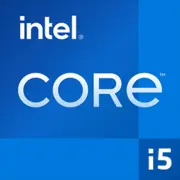Intel Core i5-6400

Intel Core i5-6400: Review and Relevance in 2025
Is it worth considering an old processor for a budget build?
1. Key Specifications: Skylake Architecture and Its Legacy
The Intel Core i5-6400, released in 2015, is part of the sixth generation of Skylake architecture. Despite its age, it is still found in budget PCs and upgrade systems.
- Process Technology: 14 nm. At the time of its release, this was a breakthrough that provided a balance between performance and energy efficiency. However, by 2025, 14 nm technologies have been replaced by 7–10 nm chips (such as Intel Alder Lake or AMD Zen 4).
- Cores and Threads: 4 cores / 4 threads. The absence of Hyper-Threading limits multitasking.
- Frequencies: Base — 2.7 GHz, maximum in turbo mode — 3.3 GHz. Sufficient for office tasks, but noticeably lagging in resource-intensive applications.
- Integrated Graphics: Intel HD Graphics 530. Suitable for basic image output and light gaming (e.g., CS:GO on low settings achieves ~40 FPS).
- Cache: 6 MB L3. Modest capacity by modern standards (newer i5 CPUs have 12–20 MB).
- TDP: 65 W. Low energy consumption simplifies cooling choices.
Key Features:
- Support for DDR4 and PCIe 3.0 (relevant for compatibility with NVMe SSDs via adapters).
- Technologies like Intel Quick Sync Video (video encoding acceleration) and VT-x (virtualization).
2. Compatible Motherboards
The processor uses the LGA 1151 socket (first revision). Suitable chipsets include:
- H110 / B150 — basic motherboards without overclocking support. Example: ASUS H110M-K (price in 2025 — $50–70 for new stock).
- H170 / Z170 — enhanced features (more USB ports, RAID support). For example, Gigabyte Z170-HD3 ($80–100).
Selection Considerations:
- Most new LGA 1151 motherboards are already out of production. Look for leftover stock on Amazon or in niche stores.
- Ensure the BIOS is updated to a version that supports Skylake (relevant for boards released before 2016).
3. Supported Memory
- Type: DDR4-1866/2133 MHz (officially). In practice, many boards allow the use of DDR4-2400.
- Mode: Dual-channel. For optimal performance, install two modules (e.g., 2x8 GB).
- Maximum Capacity: 64 GB (but entry-level motherboards are often limited to 32 GB).
Tip: Even in 2025, DDR4-2133 remains available (16 GB — $35–40), but for tasks like video editing, it's better to choose DDR4-3200 (backward compatibility is present).
4. Power Supply Recommendations
With a TDP of 65 W, the processor has a modest impact on the system's power consumption. However, consider other components:
- Integrated Graphics: PSU of 300–350 W (example: EVGA 400 N1, $35).
- Discrete Graphics Card (e.g., NVIDIA GTX 1650): PSU starting from 450 W (Corsair CX450, $55).
Important: Do not skimp on the power supply. Cheap models (like Apevia) may operate unstably under load.
5. Pros and Cons
Pros:
- Low price ($40–60 for a new processor in 2025).
- Energy efficiency.
- Sufficient performance for basic tasks (office, browsing, HD video).
Cons:
- No Hyper-Threading — suffers in multi-threaded performance.
- Outdated architecture — lagging in games and professional applications.
- Limited support for new technologies (no PCIe 4.0, Thunderbolt 4).
6. Usage Scenarios
- Office and Study: Document work, Zoom calls, browsing with 10+ tabs.
- Multimedia: Watching 4K video (with hardware decoding), streaming.
- Light Gaming: Minecraft, Rocket League, GTA V on low settings (with GTX 1650 — up to 60 FPS).
- Home Server: Due to VT-x, suitable for virtualization (Proxmox, Docker).
User Experiences:
- “Built a PC for my parents with an i5-6400 — it has been running smoothly for 5 years” (source: Reddit).
- “In 2023, I tried to play Cyberpunk 2077 — got 20 FPS on minimum settings.”
7. Comparison with Competitors
- AMD Ryzen 5 1600 (6 cores / 12 threads, $60–80): Better in multi-threaded tasks (rendering, streaming), but requires a discrete graphics card.
- Intel Core i3-10100 (4/8, $100–120): Higher IPC, supports DDR4-2666, more relevant for 2025.
- Intel Core i5-6400 vs. Ryzen 3 3200G: AMD’s Vega 8 integrated graphics are stronger, but its cores are weaker in single-threaded tasks.
8. Practical Building Tips
1. Motherboard: Look for models with M.2 slots (e.g., ASRock B150M Pro4) for NVMe SSD.
2. Cooling: The stock cooler is sufficient, but for quieter operation, consider the Deepcool GAMMAXX 400 ($20).
3. Storage: Definitely an SSD (Kingston A400 480 GB — $30).
4. Upgrade: If more performance is needed, consider transitioning to the LGA 1200 or AM4 platform.
9. Final Conclusion: Who is the i5-6400 Suitable For?
This processor is worth choosing if:
- The budget is limited ($150–200 for the entire build).
- You need a PC for basic tasks (office, study, browsing).
- You are upgrading an old system on LGA 1151.
Why not? If you plan on gaming, video editing, or working with AI — even inexpensive Ryzen 5 5500 ($120) would be three times faster.
Conclusion
The Intel Core i5-6400 in 2025 is a niche solution. It lags behind modern counterparts but remains a workhorse for specific tasks (office, media center, simple server). Purchase it only if price and compatibility are critical, and performance is not.
Basic
CPU Specifications
Memory Specifications
GPU Specifications
Miscellaneous
Benchmarks
Compared to Other CPU
Share in social media
Or Link To Us
<a href="https://cputronic.com/cpu/intel-core-i5-6400" target="_blank">Intel Core i5-6400</a>